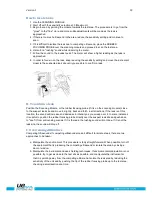
Version 1
32
Ultrasound Technology
The technology of ultrasound is concerned with sound waves that occur above human perception.
The average threshold of human perception is 16,500 Hertz. Although the highest sounds some
humans are capable of hearing is 21,000 Hertz, ultrasound technology is usually concerned with
frequencies from 20,000 Hertz and up. Another way of stating 20,000 Hertz is 20 kHz, or
KILOHERTZ. One kilo Hertz is 1,000 Hertz.
Low Freq.
High Freq.
Figure A
Since ultrasound is a high frequency , it is a short wave signal. Its' properties are different from
audible or low frequency sounds. A low frequency sound requires less acoustic energy to travel the
same distance as high frequency sound (Fig. A).
The ultrasound technology utilized by the Ultra-probe is generally referred to as Airborne
ultrasound. Airborne ultrasound is concerned with the transmission and reception of ultrasound
through the atmosphere without the need of sound conductive (interface) gels. It can and does
incorporate methods of receiving signals generated through one or more media via wave guides.
There are ultrasonic components in practically all forms of friction. As an example, if you were to
rub your thumb and forefinger together, you will generate a signal in the ultrasonic range. Although
you might be able to very faintly hear the audible tones of this friction, with the Ultraprobe it will
sound extremely loud.
The reason for the loudness is that the Ultraprobe converts the ultrasonic
signal into an audible range and then amplifies it. Due to the comparative low amplitude nature of
ultrasound, amplification is a very important feature.
Although there are obvious audible sounds emitted by most operating equipment, it is the
ultrasonic elements of the acoustic emissions that are generally the most important. For
preventative maintenance, many times an individual will listen to a bearing through some simple
type of audio pick-up to determine bearing wear.
Since that individual is hearing ONLY the audio elements of the signal, the results of that type of
diagnosis will be quite gross. The subtleties of change within the ultrasonic range will not be
perceived and therefore omitted.
When a bearing is perceived as being bad in the audio range it is in need of immediate
replacement.
Ultrasound offers a predictable diagnostic capacity. When changes begin to occur in the ultrasonic
range, there is still time to plan appropriate maintenance. In the area of leak detection, ultrasound
offers a fast, accurate method of locating minute as well as gross leaks. Since ultrasound is a short
wave signal, the ultrasonic elements of a leak will be loudest and most clearly perceived at the leak
site. In loud factory type environments, this aspect of ultrasound makes it even more useful.
Most ambient sounds in a factory will block out the low frequency elements of a leak and there by
render audible leak inspection useless. Since the
Ultraprobe is not capable of responding to low
frequency sounds, it will hear only the ultrasonic elements of a leak. By scanning the test area, a
user may quickly spot a leak
Electrical discharges such as arcing, tracking and corona have strong ultrasonic components that
may be readily detected. As with generic
detection, these potential problems can be detected in
noisy plant environments with the
Ultraprobe
Содержание Ultraprobe 3000
Страница 1: ...Version 1 1 Ultraprobe 3000 Instruction Manual ...
Страница 6: ...Version 1 6 Ultraprobe 3000 ...




































